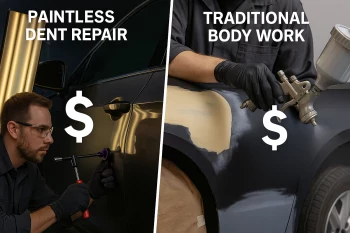When your vehicle suffers dents or dings—whether from hailstorms, parking lot mishaps, or other unfortunate incidents—you're faced with a decision: Should you opt for traditional dent repair or the newer paintless dent repair (PDR) technique? Understanding the difference between these methods can save you significant time and money.
What Are Your Options for Dent Repair?
Before diving into the cost comparison, let's clarify what each repair method entails:
Traditional Dent Repair: The Conventional Approach
Traditional dent repair has been the standard method for decades. This process typically involves:
- Sanding down the damaged area
- Applying body filler (often known as "Bondo")
- Sanding the filler to match the original contours
- Priming the repaired area
- Matching and applying new paint
- Blending the new paint with the surrounding area
- Applying clear coat for protection
- Buffing and polishing to match the original finish
This multi-step process requires specialized equipment, materials, skilled labor, and significant time.
Paintless Dent Repair: The Modern Alternative
Paintless dent repair, which emerged in the 1980s but gained widespread popularity in recent decades, takes a fundamentally different approach:
- Accessing the dent from behind the panel (often through removing interior panels or trim)
- Using specialized tools and techniques to massage the metal back to its original shape
- Gradually working the dent out without disturbing the factory paint finish
- Minor finishing touches to ensure the repair is undetectable
PDR requires no fillers, sanding, or painting, which dramatically changes the repair equation.
Cost Comparison: Breaking Down the Numbers
When comparing costs between these two methods, several factors come into play:
Direct Repair Costs
Traditional Dent Repair:
- Average cost for minor dents: $350-$750
- Average cost for moderate dents: $750-$2,000
- Average cost for severe damage: $2,000-$5,000+
These costs reflect labor hours (typically 4-10+ hours), materials (fillers, primers, paint, clear coat), shop overhead, and equipment usage.
Paintless Dent Repair:
- Average cost for minor dents: $75-$200
- Average cost for moderate dents: $200-$500
- Average cost for severe hail damage (multiple dents): $1,000-$2,500
PDR technicians typically charge based on dent size, location, and accessibility rather than hourly labor.
According to industry data from the National Alliance of Paintless Dent Repair Technicians, PDR typically saves consumers 60-80% compared to traditional repair costs for comparable damage.
Time-Related Costs
Beyond the direct repair expenses, consider these additional factors:
Vehicle Downtime:
- Traditional repair: 2-5 days (sometimes longer)
- PDR: Usually same-day service (1-3 hours for single dents, 1-2 days for extensive hail damage)
Rental Car Expenses:
- Traditional repair may require rental car coverage ($30-$70 per day)
- PDR rarely requires alternative transportation arrangements
As Mitch Wilson, a certified PDR technician with 15 years of experience, explains: "Time is money. When customers choose PDR, they're not just saving on the repair cost—they're saving on rental cars and avoiding the hassle of being without their vehicle for days."
Long-Term Value Impact: Beyond the Initial Repair
The true cost comparison must consider long-term implications as well:
Vehicle Resale Value
Traditional Repair Impact: According to Carfax data, vehicles with documented body repairs using traditional methods may lose 10-20% of their resale value compared to similar vehicles with no repair history.
PDR Impact: Since PDR preserves the original factory finish and doesn't involve structural modifications like fillers, it generally has minimal to no impact on resale value. In fact, many dealers won't even consider PDR as "body repair" in the traditional sense when assessing vehicle history.
A 2023 study by the Used Car Market Report found that vehicles repaired using PDR maintained an average of 5-15% higher resale value than those with traditional body repairs for similar damage.
Insurance Considerations
Another financial factor to consider:
Insurance Premium Effects:
- Major traditional body repair claims may influence future insurance rates
- PDR claims are typically smaller and less likely to significantly impact premiums
- Many PDR repairs fall under insurance deductibles, allowing consumers to pay out-of-pocket without filing claims
Warranty and Longevity Factors
The quality and durability of repairs also affect total cost of ownership:
Traditional Repair Warranties:
- Paint warranties typically range from 1-5 years
- May develop issues over time (paint mismatch, clear coat failure, "ghost lines" where repairs were made)
PDR Warranties:
- Many PDR technicians offer lifetime warranties on their work
- With no paint matching or fillers involved, fewer long-term concerns exist
James Chen, an automotive appraiser with 20+ years of experience, notes: "When examining vehicles with older repairs, we can almost always spot traditional body work, while PDR repairs remain virtually undetectable. This difference becomes significant when determining a vehicle's value."
When Each Method Makes Financial Sense
Despite PDR's clear cost advantages in many scenarios, traditional repair remains necessary in certain situations:
Paintless Dent Repair Is Most Cost-Effective For:
- Dents where the paint isn't cracked or damaged
- Hail damage across multiple panels
- Door dings and minor collision dents
- Dents on aluminum panels (which are particularly expensive to repair traditionally)
- Vehicles with higher values where maintaining original finish is important
Traditional Repair May Be More Cost-Effective When:
- Paint is already damaged, cracked, or scratched
- Metal is severely creased or stretched beyond PDR restoration capability
- Access behind the panel is impossible (some structural areas)
- The vehicle already has significant pre-existing damage or poor paint condition
Case Studies: Real-World Savings Examples
Let's examine some typical scenarios to illustrate the cost differences:
Case 1: Door Ding in Shopping Mall
Traditional Repair: $450 (includes blending paint with adjacent panels) PDR Repair: $125 Savings: $325 (72%)
Case 2: Hail Damage to Hood, Roof, and Trunk
Traditional Repair: $3,200 (includes painting multiple panels) PDR Repair: $1,200 Savings: $2,000 (62.5%)
Case 3: Crease Dent in Quarter Panel
Traditional Repair: $950 (includes blending with adjacent panels) PDR Repair: $350 Savings: $600 (63%)
Sandra Rivera, a financial advisor specializing in personal finance, explains: "Many consumers don't realize that choosing PDR for qualifying dents is one of the highest-return financial decisions they can make for their vehicle. The cost-benefit ratio is exceptional."
How to Make the Right Financial Choice
To maximize your savings when facing dent repair decisions:
- Always get estimates for both methods when applicable
- Ask about diminished value implications of each repair approach
- Consider your ownership timeline (selling soon vs. keeping long-term)
- Check if your insurance offers PDR-specific benefits (some have lower or no deductibles for PDR)
- Ask about warranties with both repair methods
- Research technician certification (for PDR, look for technicians certified by organizations like the National Alliance of Paintless Dent Repair Technicians)
Finding Quality Repair at the Right Price
Price shopping for repairs requires understanding what constitutes quality work:
Signs of Quality PDR Service:
- Technician willingness to show before/after photos of previous work
- Certification and training documentation
- Clear explanation of what can and cannot be repaired with PDR
- Detailed written estimate
- Warranty offerings
Red Flags for PDR Services:
- Extremely low prices (may indicate inexperience)
- Unwillingness to provide references or examples
- Guarantees that seem unrealistic for severely damaged areas
- No clear business history or online presence
Technological Advancements Affecting Costs
Recent developments continue to influence the cost equation:
Traditional Repair Challenges:
- New vehicle paint technologies (tri-coats, special finishes) have increased traditional repair costs by 15-25% over the past decade
- Advanced materials like carbon fiber and specialized aluminum alloys require more expensive traditional repair processes
PDR Innovations:
- LED lighting technology has improved technicians' ability to see and repair dents precisely
- New tool designs allow access to previously unreachable areas
- Training improvements have expanded the range of repairable damage
The Environmental Cost Factor
While not directly affecting your wallet, environmental considerations represent real costs:
Traditional Repair Environmental Impact:
- Chemical usage (paints, solvents, fillers)
- Energy consumption for spray booths and curing
- Waste products requiring special disposal
PDR Environmental Benefits:
- No chemical usage
- Minimal waste generation
- Lower energy requirements
Some insurance companies now offer "green repair" discounts that can provide additional savings when choosing PDR.
Expert Insights on Cost-Effective Choices
Industry professionals offer these additional perspectives on maximizing value:
Thomas Wright, body shop manager with 25 years of experience: "For consumers focused on value, I always recommend exploring PDR first. Even in my traditional body shop, we partner with PDR technicians because it's often the most cost-effective solution for our customers."
Maria Sanchez, consumer automotive advocate: "Understanding the capabilities and limitations of PDR can save consumers thousands over their vehicle ownership lifetime. Education is key—many people still automatically assume traditional repair is necessary for dents that PDR could easily fix."
Conclusion: The Verdict on Savings
When analyzing the total financial picture—initial repair costs, time savings, resale value preservation, and long-term quality—paintless dent repair clearly offers superior value in most applicable scenarios, with typical savings of 60-80% compared to traditional methods.
However, the key qualifier is "applicable scenarios." The wisest financial approach is having damage assessed by professionals experienced in both techniques to determine whether your specific situation allows for the PDR advantage.
By understanding the financial implications of both repair methods, you can make informed decisions that protect both your vehicle and your wallet when facing inevitable dents and dings.
Frequently Asked Questions
Q: Does the color of my vehicle affect the cost difference between PDR and traditional repair? A: Yes. Dark-colored and metallic finishes are typically more challenging and expensive to match with traditional repair, making the savings with PDR even more significant for these vehicles.
Q: Are there dents that look repairable with PDR but actually aren't? A: Yes. Sharp creases, dents with stretched metal, and damage near complex body lines may appear repairable to the untrained eye but might require traditional methods. A qualified PDR technician can assess this accurately.
Q: Will my insurance company prefer one method over the other? A: Many insurance companies now actively prefer PDR when applicable due to lower costs and higher customer satisfaction. Some even have specific PDR programs with separate, lower deductibles.
Q: Does the age of my vehicle influence which repair method is more cost-effective? A: Generally, older vehicles with already-diminished value might warrant PDR even more strongly, as the cost of traditional repair might exceed the proportional value of the vehicle itself.
Q: Are there any DIY PDR kits worth considering for minor dents? A: While DIY kits exist, they rarely provide professional results and can potentially worsen damage. The tools and techniques used by professional PDR technicians require extensive training and experience to master.
By choosing the repair method that aligns with your specific damage situation and financial priorities, you can ensure you're getting the most value from your automotive repair investment.




